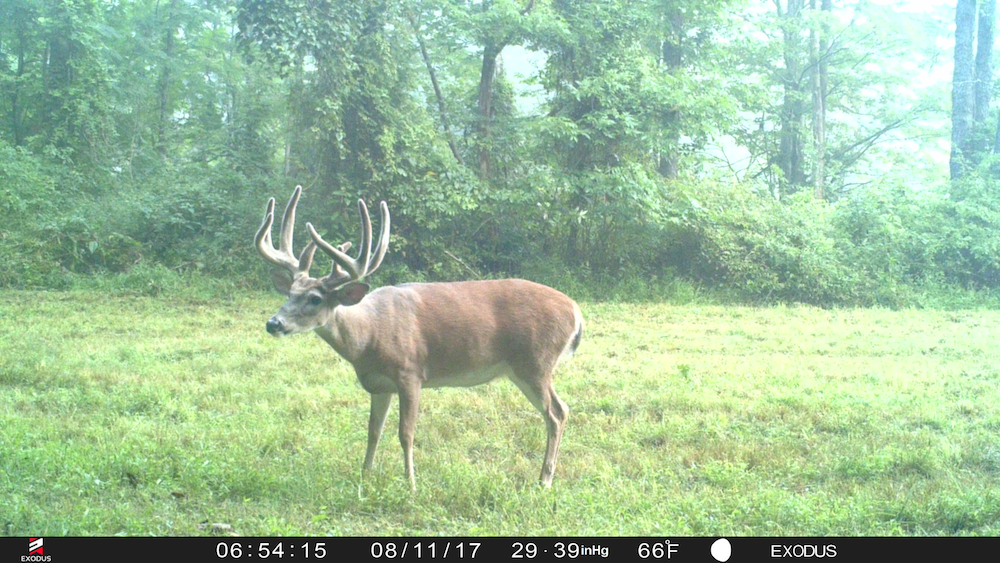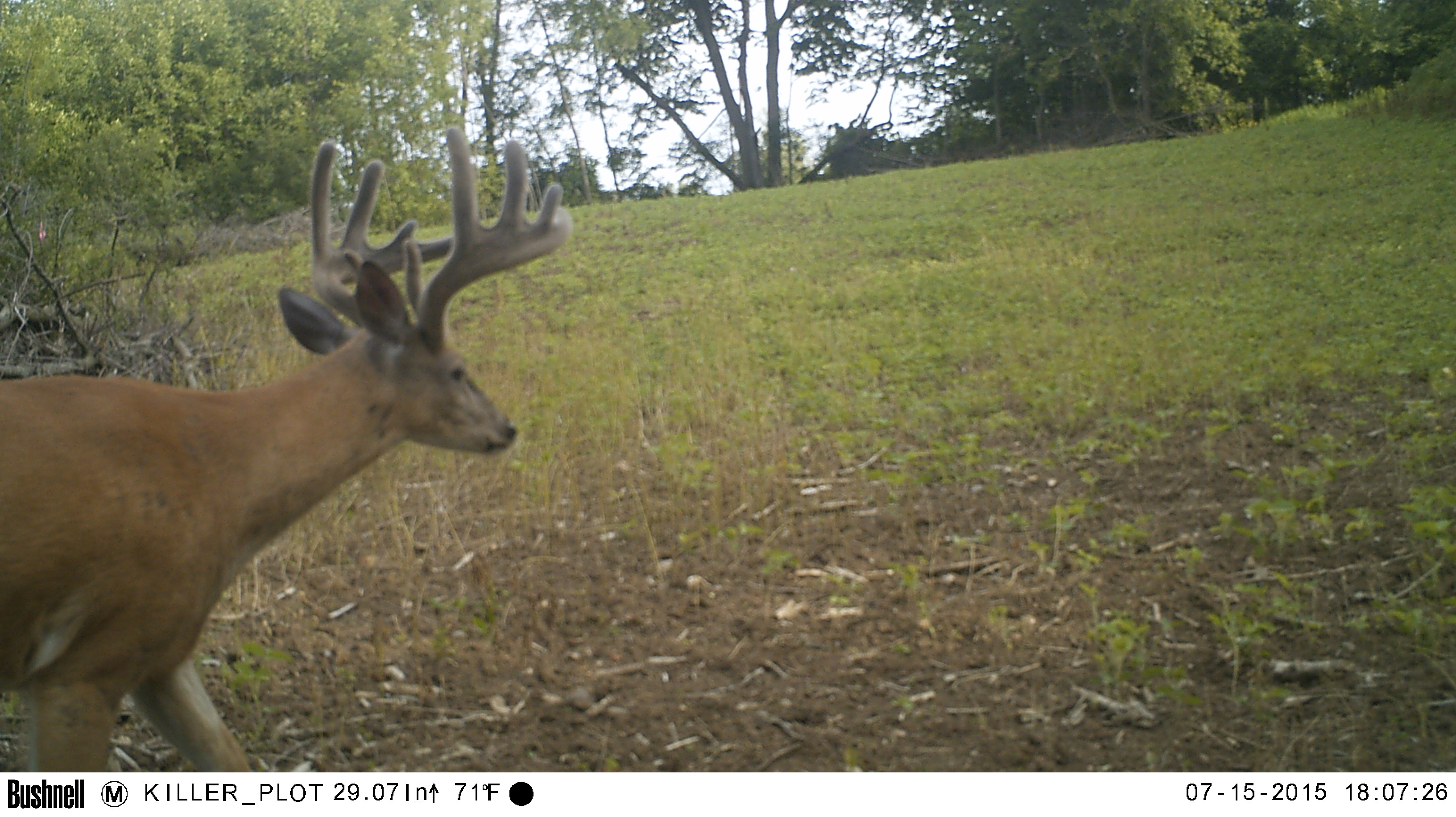Summer is the best time of year to gather an inventory of the local deer herd frequenting your hunting property. Bucks are very patternable during the summer for a variety of reasons. First, the extended daylight combined with zero hunting pressure increases the number of daytime photos. Secondly, the green beans and bachelor group nature of bucks during this time of year makes them fairly easy to find. If you’re like me and enjoy waiting for bucks to show up that you were aware of the season prior, running your cameras from June through August is a fun way to see who made it through the winter. Plus, you get to watch their antlers develop throughout the summer.
Why Scout During the Summer?
Deer are creatures of habit, but quick to adapt to new ones if hunting pressure bears down on them, or food sources run scarce. The late spring and summer months are practically void of hunting pressure and the extended sunlight and warmer climate promotes plush food sources and an abundance of cover for the deer to thrive on. Because food is plentiful during the summer, bountiful eating creates a surplus of energy. The more energy a deer has, the further it’s willing to travel between bedding and food, unlike the late winter season when deer tend to bed extremely close to food sources as a means to conserve their diminished energy levels.
So, what’s the catch?
We know that deer will bed in the safest, most remote places they can find, so long as they have sufficient energy to travel from those daytime bedding areas to the evening food sources. The longer the deer are on their feet, the better the odds of picking them up on camera. Take advantage of this opportunity to place multiple cameras surrounding any of the main food sources on the land. Often, you’ll capture multiple images of the same deer on two different cameras. Take note of the time on the pictures and pay attention their direction of travel, you can use this information later to hone in on areas to hunt once the season rolls around.

Human pressure is a major deterrent to patternable deer behavior – plain and simple. If you’re hunting them, they’ll catch on to your repetitive intrusions and throw you a curve ball by avoiding the areas you’re frequenting. Sometimes this means the deer will create alternate routes to and from bedding to food, and other times it means traveling under the cover of darkness to avoid detection. This isn’t a phenomenon, it’s survival, and deer are masters of the art of survival. With hunting pressure nearly non-existent during the summer, there really is no better time to hang your cameras near food sources and let them collect an inventory of what deer are around.
Where to Hang Trail Cameras
Your approach to how and where you hang your trail cameras can make or break the results you hope for. Here are some things to consider before you hang cameras this season.
Human scent can remain for several days up to a couple weeks after you hang a camera, so it’s always a good idea to pick less intrusive spots to hang a camera. One of my favorite areas to place a camera in the summer months is along field edges where I know the deer are frequenting. While not every property has crop fields or food plots, the idea remains – if food exists, that’s where your camera will be most effective. Rather than invading intimate space, like core bedding areas and bottlenecks, you’re keeping those areas clean of human intrusion and banking on the deer coming to your camera, rather than you taking your camera to the deer. Hanging cameras on food sources enhances the consistency of images because the deer will always return to the food, whereas their travel routes to and from their bedrooms may vary day to day based on conditions and other factors.
If motor vehicle travel is an option along a field edge, take advantage of the benefit behind driving up to the immediate tree, or fence post, that you plan to set the camera. Do this to avoid leaving a foot trail behind and hindering future deer movement in that area. If you can’t get a truck or ATV down the field edge, a bicycle is another great option. Even if your only option is to walk out, hanging trail cameras along the edge where you can walk the dirt edge (lessening the scent you leave behind) makes it less intrusive and more “normal” to deer.

On public land, leaving trail cameras behind can be a gamble. It’s public land, so as deep as you venture the chance exists for someone like you to go through what you did to get back there, also. Unfortunately, the sad reality is not everyone shares innocent values and cameras are a hot commodity to some sticky fingers. Hang your cameras high and out of reach and angled down to avoid them being easily spotted by other “hikers”. Using one climbing stick to get your trail cameras out of reachable heights is a smart move.
Since food sources aren’t always immediately available on public hunting lands, hanging cameras over natural transitions of habitat can be a solid bet. Deer will naturally walk along edges between hardwoods and cattails, or cover and open areas. While instinct might have you considering angling the camera into the open side of the transition edge, deer will often travel just inside the cover side of that edge so they are more hidden when they’re on their feet, but close enough to the open to see out and use their vision to feel safe. Look for a trail in the first fifteen yards of the transition edge on the denser side and place your camera over that trail.
Be Patient When Checking Trail Cameras
It’s easy to let curiosity get the better of you and check your cameras often, but consider one thing – the more you visit the camera, the fewer pictures you’ll get over time. Not only will deer smell your presence long after you’re gone, but they can decipher the difference between fresh and old. If you’re frequently visiting the camera site the deer will know and it puts up a red flag for an animal that depends on their nose to stay alive.
Ask yourself if you’re hunting for pictures, or hunting for the actual deer. If you’re after pictures then maybe you don’t care if the images are during the day, or after dark. However, if it’s the actual deer you’re hunting, then consider limiting your camera visits to keep the area clean so the deer continue to feel comfortable visiting the area at any time of the day. The worst that can happen from repeatedly checking your cameras is the deer will go nocturnal, or completely avoid the area altogether. This not only affects the number of pictures you’re getting, but it greatly disrupts their natural movement and makes hunting those deer much more challenging.
Do some research and try to find a camera with a good reputation for maintaining long-lasting battery life. The Exodus Lift II is one proven camera that performs at the same level in all weather conditions, hot or cold, and produces superior quality at a moderate price. Whichever camera you trust, consider letting it do its job over the course of the summer before pulling the card to get a solid handle on what’s happening on the property you’re hunting. Remember, if you’re doing anything related to deer hunting, simply use the tag #VelvetFest to be entered into the Velvet Fest Giveaway where thousands of dollars of gear is being given away to weekly winners.







